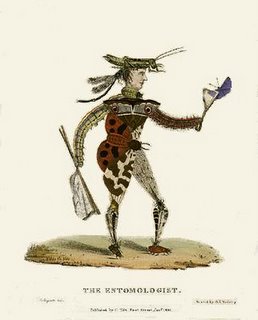My understanding is that Italian painter Giuseppe Arcimboldo created a genre by representing the human form with inanimate objects in the 16th century - some of which included tradesmen.
At the end of the 17th century Nicolas de l'Armessin (one of them: there were a few artisans by that name) engraved a series of plates - Costumes Grotesques - in which tradesmen and their occupations were depicted with the tools of their trade as body parts.
In 1730 Martin Engelbrecht released his series of similar figures to de l'Armessin (Assemblage nouveau des manouvries habilles).
During the 19th century when the idea of physiognomy - judging characters by their physical appearance (eg. phrenology) - had its greatest following, English lithographic artists GE Madeley and G Spratt released another series (itself after Cooke's 'Implemental Characters') of occupation prints. The pseudo-anthropomorphic illustrations were issued just prior to the Victorian industrial period when satirical presentation of the 'machine-age' was common.
Originally I came across an interesting engraving by Engelbrecht which sent me searching and reintroduced me to the fantastical images by de l'Armessin, one of which was included among the antique glasses engravings link I posted a couple of weeks ago. I had seen some of them before but had resisted posting until now because most of the online images were posters with gaudy colouring. I much prefer the black and white illustrations of the set posted above.
- de l'Armessin black and white engravings at the Shapero Gallery - there are 4 pages of images followed by a page with Engelbrecht engravings.
- The Madeley series of lithographs at the Glazer Gallery (despite being a commercial gallery, I've been impressed on a number of occasions in the past with the quality of both the eclectic images they have and the extent of their research)
- de l'Armessin in colour and again and again and de l'Armessin puzzles
- Physiognomy

























2 comments :
I think that should be de l’Armessin rather than de l’Armessier. I happened upon his Costumes Gortesques a couple of years back. I wonder if Arcimboldo was indeed the inventor of this genre: certainly there is at least one ‘composed head’ which pre-dates his work… I can’t help thinking that Arcimboldo’s Librarian and Gardener might also have been inspired by earlier works.
Oh thanks for that squire - I blame the little people for the spelling anomaly - I'm in the country being interrupted (happily so) by neices and nephews at times.
And truth be known, I was relying upon the summary from Glazer about the work of Arcimboldo.
That de Cazi image is amusing - didn't realize it was a profession! ;- )
Post a Comment
Comments are all moderated so don't waste your time spamming: they will never show up.
If you include ANY links that aren't pertinent to the blog post or discussion they will be deleted and a rash will break out in your underwear.
Also: please play the ball and not the person.
Note: only a member of this blog may post a comment.